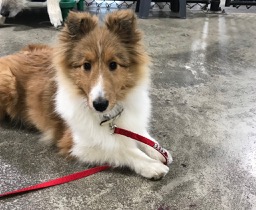
5 Remote Collar Tips for Fearful Dog Training Success
March 12, 2018 Category: News, Trainer Tips
I have often been asked if a remote collar can be used for shy or fearful dog training. My response is always a confident, “Yes, it is actually one of my preferred tools for working with shy dogs.”
That response is surprising to some, but once you recognize the versatility of the tool, it makes perfect sense. A remote collar can be used to gain attention through very subtle tactile cues, which makes it ideally suited to dogs that are shy, reserved, anxious, or fearful. Dogs that might easily become overwhelmed by other stimuli in the environment can be gently guided to pay better attention to their handler. Once attention is gained, the handler can begin to help an anxious dog navigate the world in a more calm and confident way.
What to Do if Your Dog is Scared of an E-Collar
Today's modern remote training collar is a tool that is highly adjustable. The levels of stimulation can be dialed in to suit a dog's individual sensitivity, and that is a key factor in gaining a successful outcome. The ability to communicate through the sense of touch reduces the possibility of any confrontation through voice, inappropriate body language, or difficult leash handling. Once a person learns the proper techniques to use the collar as a communication tool, it is amazing how responsive and trusting even the shyest dog can become.
Introducing a dog to a remote training collar requires patience and a gradual approach. Start by allowing your dog to investigate the collar while it is turned off, then gradually introduce them to the stimulation levels. It's important to avoid using the collar as a form of punishment and to focus on positive reinforcement to help your dog understand the tool.
5 Tips for Fearful Dog Training Using an E-Collar
With proper training and positive reinforcement, even the most fearful dog can learn to trust and respond to a remote training collar. If you only understand how to use a remote collar as punishment for bad behavior or non-compliance to obedience, then I suggest you hold off using it on a reserved dog for now. But if you’re ready to expand your skills and learn something new, here are a few tips to remember:
1. Limit Distractions When Introducing E-Collar Stimulation
Introduce remote collar stimulation in an area with limited distractions. The initial goal when collar conditioning is to help the dog understand how to control the sensation. It is much easier for a dog to focus and learn any new skill when the mind is not bombarded with all sorts of surrounding stimuli. This can be particularly important for a shy dog.
2. Use High-Value Rewards to Build Trust and Attention
Use high-value rewards in the early weeks of training. One of the challenges for a shy or fearful dog training is learning to pay attention to their owner in situations where other stressful distractions (dogs, strangers, noises, etc.) are in the surroundings. Fearful dogs struggle with relinquishing attention to their owners because they believe they have to keep a watchful eye on everything else in order to stay safe. Use the remote collar to increase the dog’s ability to pay attention and pair that with high-value treats, praise, and play. This will reinforce to the dog that they really are safe, allowing you to make decisions for them about how to behave and what to do. You want your dog to have faith in your ability to be a safe guide through the otherwise “scary” terrain of new environments.
3. Focus on Movement to Promote Calm Behavior
Keep in mind the expression “Movement dissipates stress.” Shy or fearful dogs often have a difficult time holding a ‘Stay’ position as people, dogs, or other triggers approach. They often feel trapped and, thus, either flee or choose to react aggressively if a flight is not an option. In situations that build stress, learning calm behavior can be expedited by using training strategies that focus on movement rather than holding still. Insisting your dog's heel by your side or coming when called (away from the “scary” thing) can help the dog learn to tune into you for guidance. As the dog learns paying attention to you “keeps him safe,” you can begin to add more stationary behaviors like ‘Sit’ and ‘Down’ into the training.
4. Build Confidence Through Movement and Agility
Build confidence through movement and “urban agility.” Shy dogs can begin to blossom by helping them succeed at physical tasks that are out of their comfort zone. For instance, many dogs may shy away from walking on a suspended platform, hesitate to jump over a downed tree, or balk at walking through a stream. Leading your dog over, under, across, and through a wide variety of obstacles will help develop confidence, much the way children blossom by learning to ride a two-wheeled bike, jump off a diving board, or scale a rock climbing wall. Conquering physical challenges builds muscle development and control, bu14t more importantly, builds the mental confidence to face fears in a productive way. Participating in an agility class can work well, but also make sure you find an instructor that will support your dog and not allow them to be bullied or charged by the more exuberant canines in the class.
5. Keep Calm and Carry On Training
Keep a calm and confident demeanor. If you’ve ever been in a situation where you felt anxious, you know the relief that goes along with having a confident, capable person step forward and take charge of the situation. Learn to be that confident person for your dog. If you seem unsure, it will travel down the leash, so lead by example.
Final Thoughts
Helping a shy dog gain confidence through training is a very rewarding experience. As you go through the process, think of yourself as a physical therapist that is strategically assisting the dog to grow and get better







